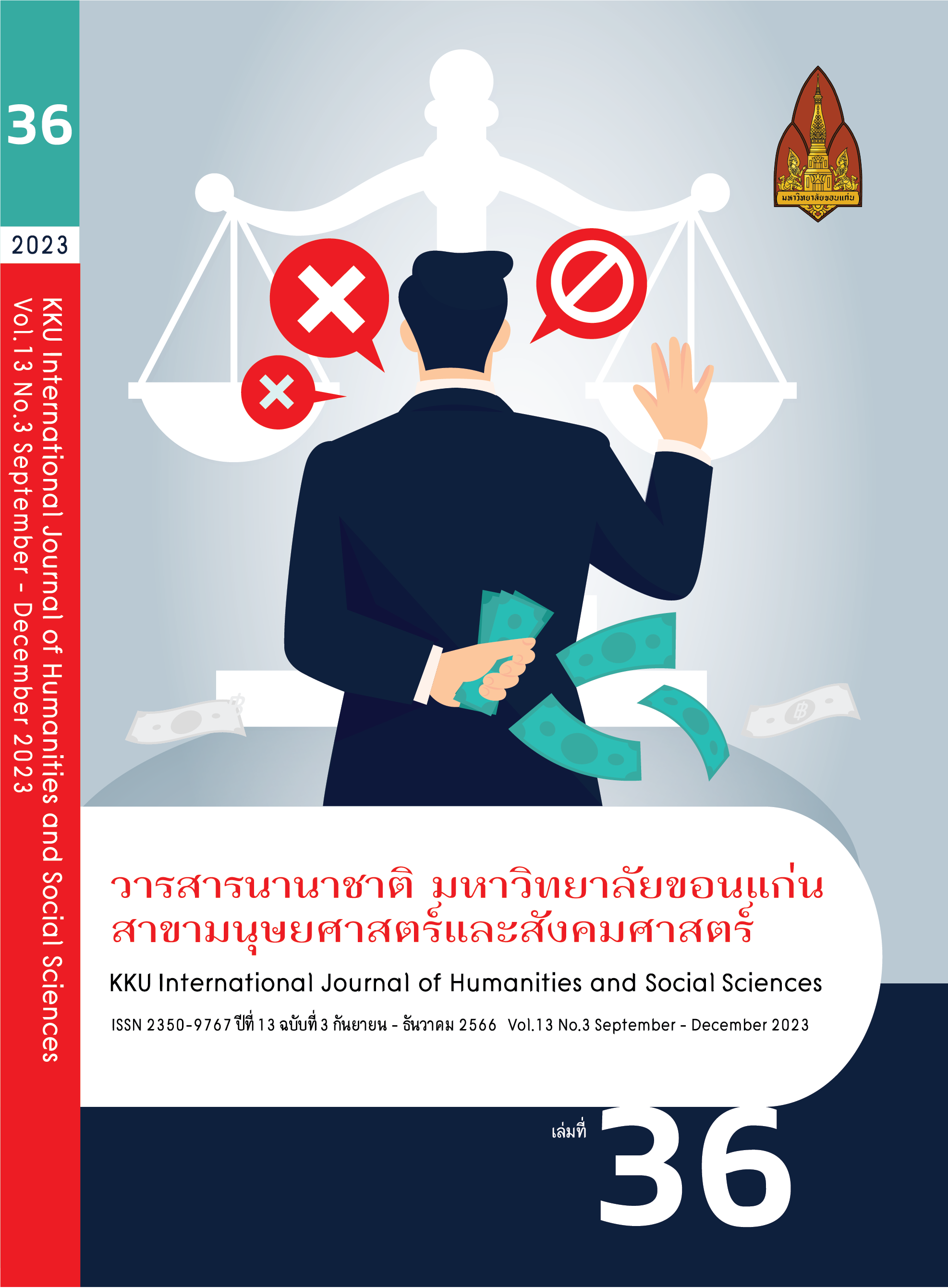Work Patterns of Commuter in a Core City
Main Article Content
Abstract
This study examined the work patterns of commuter in one of Thailand’s core cities, namely Khon Kaen, and identified the factors correlating with these work patterns. Quantitative research methods were used with individual units of analysis. The sample included 1,013 workers who were commuted to Khon Kaen Province. The sample was determined using random sampling from micro data reported in the Population Migration Survey Program by the National Statistical Office of Thailand and was collected from October to December, 2019. Descriptive and Chi-Square Statistics were used for analysis. The findings showed that of the commuter who commuted to work in Khon Kaen Province, 56.0% worked in the agricultural sector (agriculture, forestry, and fishing); 29.8% in the service sector (wholesale, retail, and motorcycle and automotive repair); and 14.2% in the industrial sector. Factors correlating with the work plans of this population (with a statistical significance of 0.05) included the worker’s sex, age, education level, and employment status, as well as their work hours per week, commuting plans, distance travelled per day, and monthly travel expenses.
Article Details
References
สำนักงานสภาพัฒนาการเศรษฐกิจและสังคมแห่งชาติ. (2560). ยุทธศาสตร์ชาติ 20 ปี (พ.ศ. 2561-2580). สืบค้นเมื่อ 3มิถุนายน 2563, จาก http://www.nesdc.go.th/download/document/SAC/NS_PlanOct2018.pdf
สำนักงานสภาพัฒนาการเศรษฐกิจและสังคมแห่งชาติ. (2562). พัฒนาพื้นที่ไทย :เชื่อมไทย ก้าวไกล เชื่อมโลก. สืบค้นเมื่อ 3 มิถุนายน 2563, จากhttps://www.
nesdc.go.th/more_news.php?cid=16
สำนักงานจังหวัดขอนแก่น. (2561). แผนพัฒนาจังหวัดขอนแก่น พ.ศ. 2561– 2565. ค้นเมื่อ 7 พฤศจิกายน 2563, from http://www.khonkaen.go.th/khonkaen6/fileDir/vision/20200709-KKDevelopPlan61-65.rar
สำนักงานสถิติแห่งชาติ. (2562). ผลิตภัณฑ์มวลรวมจังหวัดต่อคน ตามราคาประจำปีจำแนกเป็นรายภาค และจังหวัด. สืบค้นเมื่อ 3 มิถุนายน 2563, จาก http://
statbbi.nso.go.th/analytics/saw.dll?dashboard
สำนักงานสถิติแห่งชาติ. (2562). สำรวจประชากรแฝง พ.ศ. 2562. กรุงเทพฯ: สำนักงานสถิติแห่งชาติ.
สำนักงานสถิติแห่งชาติ. (2563). สถิติโรงงานอุตสาหกรรมที่จดทะเบียนกับกระทรวงอุตสาหกรรม และได้รับอนุญาตให้ประกอบกิจการใหม่ (ตามพระราชบัญญัติโรงงาน พ.ศ. 2535) จำแนกตามประเภทโรงงานภาค และจังหวัด. สืบค้นเมื่อ 3 มิถุนายน 2563, จาก http://statbbi.nso.go.th/analytics/saw.dll?dashboard
ดุษฎี ช่วยสุข และดลฤทัย โกวรรธนะกุล. (2558). การพัฒนาศักยภาพอุตสาหกรรมไมซ์ในจังหวัดขอนแก่นเพื่อรองรับการเป็นไมซ์ซิตี้ของประเทศไทย. วารสารการบริการและการท่องเที่ยวไทย, 10(1), 15-29.
ดุษฎี อายุวัฒน์. (2562). ศาสตร์และวิธีวิทยาการศึกษาการย้ายถิ่นของประชากร. ขอนแก่น: คลังนานาวิทยา.
บัวพันธ์ พรหมพักพิง, ยรรยงค์ อินทร์ม่วง และมนต์ชัย ผ่องศิริ. (2562). เมืองขอนแก่น: การเติบโต ความท้าทาย และโอกาส. ขอนแก่น : กลุ่มวิจัยความอยู่ดีมีสุขและ การพัฒนาอย่างยั่งยืน คณะมนุษยศาสตร์และสังคมศาสตร์ มหาวิทยาลัยขอนแก่น.
อริสา จันทรบุญทา และจิรัฐ เจนพึ่งพร. (2561). ความเป็นเมือง (Urbanization) และนัยเชิงนโยบายของไทย. กรุงเทพฯ : ธนาคารแห่งประเทศไทย
อำนาจ จำรัสจรุงผล. (2558). ผลกระทบของการพัฒนาเมือง ต่อการอนุรักษ์พื้นที่สีเขียวภาคการเกษตร กรณีศึกษาคลองอ้อมนนท์ จังหวัดนนทบุรี. วารสารหน้าจั่ว ว่าด้วยสถาปัตยกรรม การออกแบบ และสภาพแวดล้อม, 29, 371–385.
Engelfriet, L., & Koomen, E. (2018). The impact of urban form on commuting in large Chinese cities. Transportation, 45(5), 1269-1295.
Guerra, E., Zhang, H., Hassall, L. & Wang, J. (2020). Who cycles to work and where? A comparative multilevel analysis of urban commuters in the US and Mexico. Transportation Research Part D: Transport and Environment, 87.
Leeuwen, E. (2010). Urban-Rural Interactions. New York: Springer Science & Business Media.
Liao, P. & Yip, C. (2018). Economics of Rural-Urban Migration. Retrieved October 7, 2020, from https://doi.org/10.1093/acrefore/9780190625979.013.153
Liu, T. & Ceder, A. (2016). Commuting by Customized Bus: A Comparative Analysis with Private Car and Conventional Public Transport in Two Cities. Journal of Public Transportation, 19, 55-74.
Naess, P., Tønnesen, A. & Wolday, F. (2019). How and Why Does Intra-Metropolitan Workplace Location Affect Car Commuting?.
Sustainability, 11, 1196.
Ranis, G. & Fei, J.C.H. (1961). A Theory of Economic Development. The American Economic Review, 51(4), 533-56.
Scheele, S. (2018). Municipality attraction and commuter mobility in urban Sweden: An analysis based on longitudinal population data. Urban Studies, 55(9), 1875-1903.
Schneider, D., Harknett, K. & Collins, M. (2018). Working in the Service Sector in Washington State. Retrieved March 17, 2021, from https://shift.hks.harvard.edu/files/2018/12/Working-in-the-Service-Sector-in-Washington-State.pdf
Supunya, P. & Ayuwat, D. (2019). Lifestyle of Generations in the Sub-Urban Case Study: Major Cities in Northeastern Thailand. Journal of Social and Political Sciences, 2(2), 366-374.
Thomas, M. J. (2019). Employment, education, and family: Revealing the motives behind internal migration in Great Britain. Population, space and place, 25(4), 2233.
Thorns, D.C. (2002). The Transformation of Cities Urban: Theory and Urban Life. New York: Red Globe Press.
Tsapenko, I. (2015). Social effects of immigration. Herald of the Russian Academy of Sciences. 85, 443-452.
Zelinsky, W. (1971). The hypothesis of the mobility transition. Geographical Review, 61(2), 214-249.
Zhu, Z., Li, Z., Liu, Y., Chen, H. & Zeng, J. (2017). The impact of urban characteristic sand residents’ income on commuting in China.
Transportation Research Part D: Transport and Environment, 57, 474-483.


